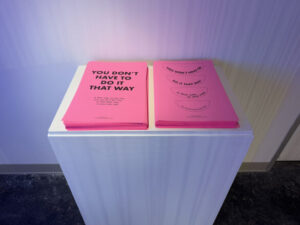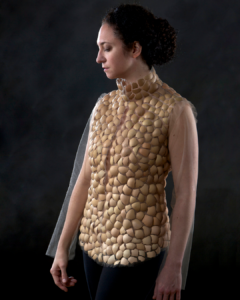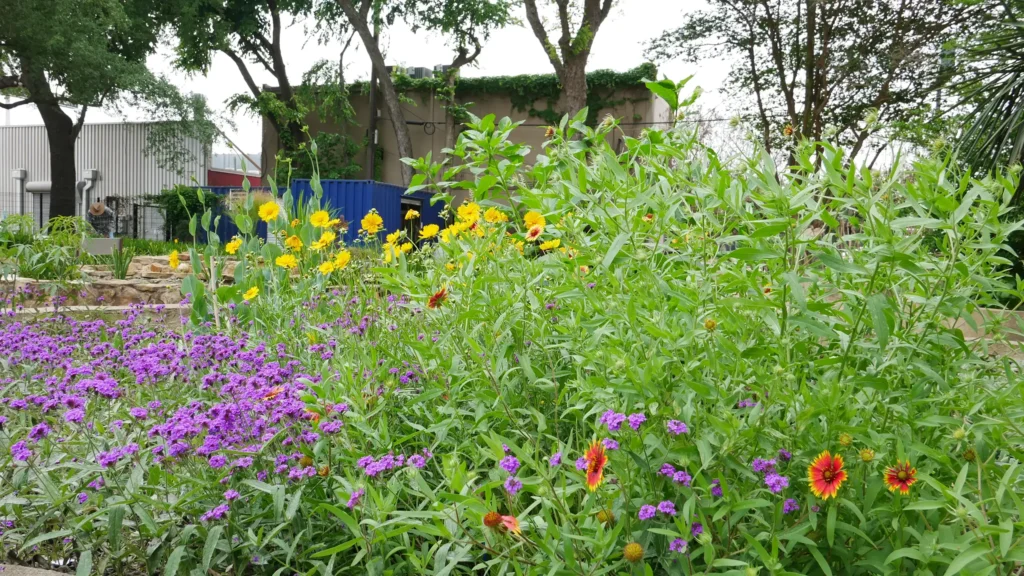Jessica Fuentes writes about a traveling exhibition that explores the role of art and design related to the experiences of menstruation, reproduction, childbearing, and caregiving.
Design, like art, is shaped by the society from which it emerges. The look, feel, and functionality of our furniture, household objects, clothing, transportation, buildings, and more, reflect our values as well as our understanding of the world and our place within it. Art museum design collections are filled with beautiful tables, fabrics, vases, silverware, communication devices, and other relics of various times and places, but I don’t recall ever encountering a collection of speculums or breast pumps. While it is more seductive to investigate and be a steward of beloved cultural objects, the design of items like IUDs, menstrual products, and baby bottles should also be considered because they too tell a story about society. The places that preserve these objects are more likely to be science or history (rather than art) museums, which is why when institutions rooted in different disciplines collaborate, unexpected and relevant exhibitions materialize.
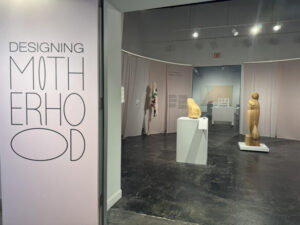
Such is the case with Designing Motherhood: Things that Make and Break Our Births, currently on view at the Houston Center for Contemporary Craft (HCCC). The inaugural iteration of the show debuted at The Mütter Museum and Historical Medical Library at the College of Physicians of Philadelphia in 2021. According to the museum’s website, the institution is a medical history museum that is dedicated to “sharing stories of medicine and public health.” The exhibition came about as a collaboration between the museum, the curatorial team (Juliana Rowen Barton, Michelle Millar Fisher, Zoë Greggs, Gabriella A. Nelson, and Amber Winick), and the Maternity Care Coalition, a local group of health and social justice activists supporting pregnant people and infants. Since 2021, Designing Motherhood has been hosted by the MassArt Art Museum in Boston (2022), The Bill & Melinda Gates Foundation Discovery Center in Seattle (2023), ArkDes in Stockholm (2024), and now HCCC.
While the original installation included five sections — Means of Reproduction, Midwives, Parturition, Exam, and Milk — later iterations have included sections titled Our Bodies Ourselves, Postpartum, Temporary Bodies, Spaces, and Monitoring. HCCC’s presentation begins with a Craft + Caregiving section, which features baby carriers, receiving blankets, and two wooden sculptures of figures. The introductory gallery sets the tone of the exhibition and roots it in the venue’s mission to showcase contemporary craft. Designing Motherhood thoughtfully considers the functionality and shifts in the design of objects used in various aspects of reproductive care, as well as the social ideas, political actions, and policies that have informed these objects. Works by contemporary artists are presented alongside tools and items, adding a further dimension of societal reflection on concepts of reproductive health and mothering.
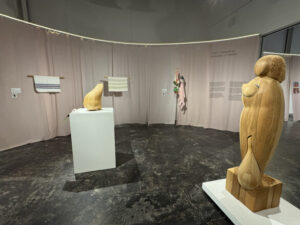
Sarah Darro, Curator and Exhibitions Director at HCCC, who organized the institution’s iteration of the show, explained her thoughts behind the Craft + Caregiving section, which is unique to the venue. She told me, “For me, the section reveals the deep craft traditions that undergird our first experiences of the material world — baby swaddling and wearing — which were represented in the original [exhibition] by the Kuddle Up Receiving Blanket and Snugli. My aim with this section was also to posit the overarching thesis that forms of caregiving are craft practices in and of themselves.”
A line in the introductory wall text explains, “Like craft, parenthood shares [the] intertwined properties of care, labor, embodied history, and familial knowledge.” As a mother and artist, I feel this intrinsically — my creative practices and approaches blend into and both inform and are informed by my parenting and caregiving. Last fall, when I visited the now-controversial Diaries of Home exhibition at the Modern Art Museum of Fort Worth, I felt seen, validated, and represented as a parent/artist in a museum for the first time. Walking into Designing Motherhood was validating in a different sense, the display of the sometimes mundane aspects of womanhood paired with historical and contemporary contexts highlighted the importance of the small and large physical, visceral experiences of menstruation, self-care, childbirth, and caregiving.
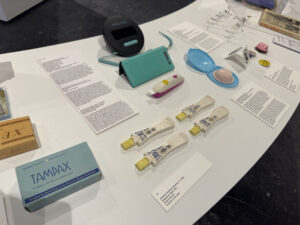
Walking through the space, the designed objects across history reaffirmed an unsurprising narrative — they spoke of the long cultural history of midwifery and how the medicalization of childbearing in the U.S. has been shaped by men with seemingly little concern for the comfort, and at times even safety, of female-identifying people. One example being the 2019 Yona Speculum Prototype Sketch, a drawing of a device designed by women to be used in pelvic examinations. This new design thoughtfully considers various aspects of the experience by covering the traditional steel object in silicone and using a design that provides nearly silent use as opposed to the unnerving clicking and ratcheting sounds of the cold, intrusive, metal object that is often inserted into the vagina to dilate it.
Woven throughout the exhibition alongside the history aspect of the show are works by artists, some of which speak directly to the objects on view and others that more broadly depict and reflect the lived experiences of women and nonbinary people. Aimee Koran’s Chromed Life (Machine Pulled), a chrome-plated breast pump, at once glorifies the object and calls into question the ongoing labor women endure as they recover from childbirth and return to the workforce. Nearby are objects related to breastfeeding and bottle feeding, including an 1879 breast pump, nipple shields from the 1700s and 1800s, and a short documentary of a design hackathon, hosted by the Massachusetts Institute of Technology’s Media Lab, called “Make the Breast Pump Not Suck.” While Koran and other artists included in the show like Alison Croney Moses, Deborah Willis, and Ani Liu, were part of other iterations of the exhibition, HCCC’s version brings in a slew of Texas artists — Jennifer Ling Datchuk, Liss LaFleur and Katherine Sobering, Francesca Fuchs, Madeline Donahue, Cynthia Mulcahy, Alicia Eggert, and others — into the conversation.
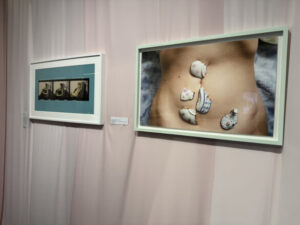
Datchuk’s One Tough Bitch, a photograph of a torso with porcelain shards partially covering a vertical abdomen scar, hangs in the Means of Reproduction section of the show. The piece alludes to kintsugi, the traditional Japanese art of repairing broken pottery with lacquer mixed with powdered gold. Though porcelain is often seen as fragile, it is a strong material and the gold edges of the broken pieces embrace the beauty of the fractures, rather than attempt to camouflage them. The photograph is a poignant reminder that a tear can be mended and that scars are visual representations of strength and endurance, not weakness.
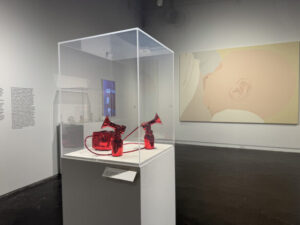
Three works included in the show that speak directly to abortion rights are Cynthia Mulcahy’s Abortion Seed Library (War Garden series), Alicia Eggert’s OURs, and René Lee Henry’s CHOICE. Each of the pieces was created in 2022, the same year as the Supreme Court’s decision to overturn Roe v. Wade and Texas’ implementation of a law that prohibits abortions in most cases. Eggert’s neon work oscillates between three phrases, “OUR BODIES,” “OUR FUTURES,” and “OUR ABORTIONS.” Similarly, Henry’s copper, resin, and steel work simply states the word “CHOICE.” These works are defiant and unyielding. They are not seeking to discuss nuance or specific aspects of abortion rights, they simply state that people should have a choice regarding their bodies.
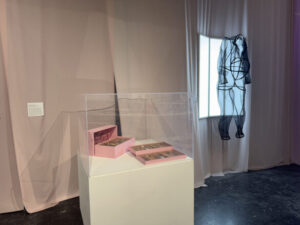
Mulcahy’s work draws on knowledge from cultures around the world and across history related to plants used to terminate pregnancies. “War garden,” another name for Victory gardens, refers to the vegetable, fruit, and herb gardens grown on residential and public land during World War I and World War II as a means to be self-sufficient during strenuous times. Women in states like Texas that have mandated near-total abortion bans find themselves in dire situations. A recent study has shown that maternal mortality rates in Texas increased 56% between 2019 and 2022. Mulcahy’s piece recognizes that we have the knowledge and ability to take control in a situation in which agency has been removed, on a political level and in a medical realm.
Designing Motherhood is multifaceted. It covers a lot of ground and highlights a myriad of lived experiences related to menstruation and reproduction. These topics, which are natural and essential parts of life, have historically been considered taboo, resulting in silence and misinformation across generations. The exhibition serves as an educational moment, emphasizing the necessity of inclusive design shaped by the people who will encounter these objects. It is a testament to the power of women’s and nonbinary people’s voices in a society where too often these voices fall on deaf ears.
